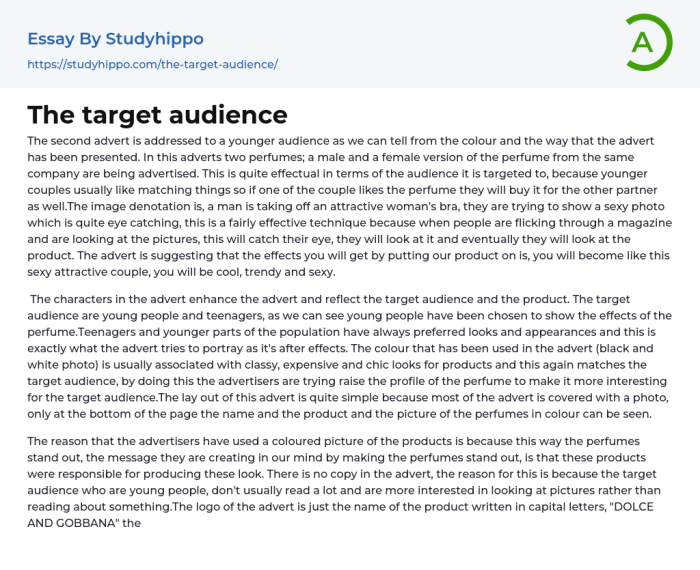Writing for a Target Audience sets the stage for creating tailored content that resonates with specific groups, diving into strategies that captivate and connect through the power of words.
Understanding audience nuances and preferences is key to crafting compelling messages that leave a lasting impact.
Understanding the Target Audience

In the realm of writing, a target audience refers to the specific group of people that a piece of content is intended for. This group typically shares common characteristics, interests, and needs that the writer aims to address through their writing.
Importance of Understanding the Target Audience
Understanding the target audience is crucial for effective communication as it allows the writer to tailor their message in a way that resonates with the readers. By knowing who they are writing for, writers can use language, tone, and content that is most likely to engage and connect with their audience.
Examples of Different Target Audiences
– Teenagers: When writing for teenagers, the content should be engaging, relatable, and use current slang or pop culture references to capture their attention.
– Business Professionals: Writing for this audience requires a more formal tone, professional language, and industry-specific jargon to convey credibility and expertise.
Importance of Demographics, Psychographics, and Behaviors
Demographics such as age, gender, income, and location provide a basic understanding of the target audience. Psychographics delve deeper into values, beliefs, and lifestyle choices. Behaviors reveal how the audience interacts with content and what motivates them to engage. By considering these factors, writers can create content that speaks directly to the needs and interests of their target audience.
Identifying Audience Needs and Preferences
To create content that truly resonates with your target audience, it is crucial to identify their needs and preferences. This involves conducting thorough research, analyzing feedback and data, and adjusting tone, language, and content accordingly. Empathy plays a key role in understanding and addressing audience needs, allowing you to connect with them on a deeper level.
Methods for Conducting Research
- Utilize surveys and questionnaires to gather direct feedback from the audience.
- Monitor social media platforms to observe conversations and trends relevant to your target demographic.
- Conduct interviews or focus groups to gain insights into the preferences and behavior of your audience.
Analyzing Feedback and Data
- Look for patterns and trends in the feedback received, identifying common themes or areas of interest.
- Utilize analytics tools to track engagement metrics and user behavior on your content.
- Seek feedback from a diverse range of audience members to ensure a comprehensive understanding of their preferences.
Adjusting Tone, Language, and Content
- Modify the tone of your content to match the preferences of your audience, whether it be casual, formal, or humorous.
- Use language that resonates with your target demographic, avoiding jargon or complex terminology that may alienate them.
- Adapt the content format to better suit the preferences of your audience, such as incorporating visuals or interactive elements.
The Role of Empathy
- Empathy allows you to put yourself in the shoes of your audience, understanding their emotions, motivations, and challenges.
- By empathizing with your audience, you can create content that addresses their needs and resonates with their values and beliefs.
- Show genuine care and concern for your audience, building trust and loyalty through your understanding of their needs.
Tailoring Content for Different Audiences
When it comes to tailoring content for different audiences, it’s essential to adjust your writing style, tone, and vocabulary to resonate with diverse groups. Connecting emotionally with various audience segments can be achieved by understanding their unique needs and preferences. Cultural differences play a significant role in shaping how we communicate, requiring sensitivity and awareness to effectively reach different target audiences. Additionally, using storytelling and personalization can help engage specific groups and create a more impactful message.
Adapting Writing Style, Tone, and Vocabulary
Adapting your writing style, tone, and vocabulary is crucial when targeting different audiences. For example, when writing for a younger demographic, such as teenagers, using a more casual and conversational tone can help establish a connection. On the other hand, when addressing professionals or an older audience, a more formal tone and sophisticated vocabulary may be more appropriate.
- Use slang and pop culture references when targeting younger audiences.
- Employ industry-specific jargon and terminology to resonate with professionals.
- Adjust the complexity of your language based on the educational background of your audience.
Emotional Connection through Writing
To connect emotionally with different audience segments, consider incorporating personal anecdotes, relatable stories, and empathetic language into your writing. By tapping into the emotions of your readers, you can create a more meaningful and memorable experience that resonates with them on a deeper level.
- Share personal experiences to establish a sense of authenticity and connection.
- Use inclusive language to make all audience members feel represented and valued.
- Appeal to common emotions such as joy, sadness, or nostalgia to evoke a response from your readers.
Cultural Influence on Writing
Cultural differences can significantly impact how writing is perceived by different audiences. It’s essential to be mindful of cultural norms, values, and preferences when crafting content for diverse groups. For example, humor that may be well-received in one culture could be considered offensive in another. By being aware of these nuances, you can avoid misunderstandings and effectively tailor your writing to appeal to a wider audience.
- Research the cultural background of your target audience to understand their expectations and sensitivities.
- Avoid using stereotypes or assumptions that could alienate certain cultural groups.
- Incorporate diverse perspectives and representation in your content to reflect the multicultural world we live in.
Engaging Audience through Storytelling, Writing for a Target Audience
Storytelling is a powerful tool for engaging specific audience groups and creating a memorable impact. By weaving narratives, anecdotes, and personal touches into your writing, you can captivate readers and draw them into your message. Personalization adds a human element to your content, making it more relatable and compelling for your target audience.
- Create a compelling narrative arc that captures the attention and imagination of your audience.
- Use descriptive language and vivid imagery to paint a vivid picture for your readers.
- Connect your storytelling to the core message or purpose of your content to resonate with your audience on a deeper level.
Crafting Compelling Messages: Writing For A Target Audience

Crafting messages that resonate with your target audience is crucial for effective communication. By following certain strategies, you can ensure that your content is clear, concise, and compelling, capturing the attention of your audience.
Structuring Content for Digestibility
When crafting messages for your target audience, it is essential to structure your content in a way that is easily digestible. Break down your message into smaller sections with clear headings, bullet points, or numbered lists to make it easier for your audience to follow along and grasp the main points quickly.
- Use short sentences and paragraphs to avoid overwhelming your audience with too much information at once.
- Incorporate subheadings to organize your content and guide your audience through the message.
- Highlight key points or important information using bold text or bullet points to draw attention to crucial details.
Incorporating Visuals and Storytelling
To enhance the effectiveness of your message, consider incorporating visuals, storytelling, and examples. Visuals such as images, infographics, or videos can help engage your audience and make complex information more accessible. Storytelling can create a connection with your audience on a personal level, making your message more memorable and impactful.
- Use relevant images or videos to support your message and break up large blocks of text.
- Tell relatable stories or use case studies to illustrate key points and make your message more engaging.
- Provide examples or real-life scenarios to demonstrate the practical application of your message and show its relevance to your audience.
Authenticity and Trustworthiness
Authenticity and trustworthiness play a significant role in delivering messages that resonate with your audience. Your audience is more likely to engage with content that they perceive as genuine and trustworthy. To build trust with your audience, ensure that your messages are authentic, transparent, and aligned with your brand values.
- Be honest and transparent in your communication to establish credibility and build trust with your audience.
- Showcase your expertise and authority on the topic to demonstrate that you are a reliable source of information.
- Engage with your audience in a meaningful way, responding to their feedback and addressing their concerns to show that you value their input.

